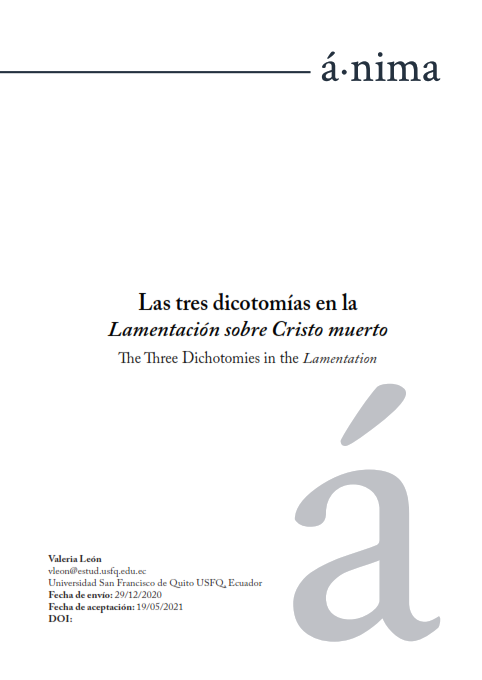The Three Dichotomies in the Lamentation
DOI:
https://doi.org/10.18272/anima.v1i.2127Keywords:
Giotto, Pre-Renaissance, dichotomies, Lamentation, Art History, fluctuationAbstract
The Lamentation (1306) is one of the 37 frescos found inside the Scrovegni Chapel, a simple church that hides, inside its small confinements and simple finishes, a cycle of transcendental paintings about the life of Jesus and Virgin Mary. The painting was concluded in the year of 1306 by the Florentine Pre-Renaissance painter, Giotto di Bondone. The current value and discussion of this image resides in its clear representation of what Pre-Renaissance art for the development of the sphere of Western art. Moreover, the importance of it lies on its strong manifestation of Giotto's ingenuity and his artistic rupture within his medium. Above all, the painting possesses great relevancy nowadays because it shows art's capacity to be maintained and keep its spectator in a constant state of fluctuation inside different dichotomies. This painting's last characteristic is the base of the present analysis, in which it is attempted to understand thoroughly three of the dichotomies the image exhibits; they are: humanity and divinity, beauty and pain, and the before and the after. Through a detailed observation and a critical study of the painting's main elements, the context that surrounds it and the three dichotomies it depicts, it will be possible to better understand the constant fluctuation in which the spectator is involved.
Downloads
References
Brennan, Mathew. "Arena Chapel / Scrovegni Chapel," Ilustración, Sketchfab, consultado noviembre 22, 2020. https://sketchfab.com/3d-models/arena-chapel-scrovegni-chapel-b149c4d44e83407db85b79188261fec7
Brucker, Gene. Florence, The Golden Age, 1138-1737. University of California Press, 1984.
Cennini, Cennino. "Capítulo I." El libro del arte, Neri Pozza Editore, 1982, 31-33, https://www.departamentoesteticas.com/SEM%201/PDF/2020/PUB/EL%20LIBRO%20DEL%20ARTE%20CENNINO%20CENNINI..pdf
Edgerton, Samuel. The heritage of Giotto's geometry. Cornell University Press, 1992, https://openlibrary.org/books/OL1534461M/The_heritage_of_Giotto%27s_geometry
Giuseppe, Cardillo, y Cecilia Echeverría. Muestra Didáctica sobre Giotto. Casa Alineari, 1960.
Gombrich, Ernst. La Historia del Arte. Editorial Diana, 1995. https://historiadelarteuacj.files.wordpress.com/2016/08/gombrich-ernst-h-historia-del-arte.pdf
Joselit, David. "Painting beside itself." October Magazine, vol. 130, 2009, pp. 125-134. www.jstor.org/stable/40368572.
Larner, John. "The Artist and the Intellectuals in Fourteenth Century Italy." History, vol. 54, no. 180, 1969, pp. 13-30, https://www.jstor.org/stable/24406508?seq=1.
Perkins, Mason F. "Giotto." The Great Masters in Painting and Sculpture. George Bell and Sons, 1902.
Schwarz, Michael Viktor. "Padua, its Arena and the Arena Chapel: A Liturgical Ensemble." Journal of the Warburg and Courtauld Institutes, vol. 73, 2010, pp. 39-64, www.jstor.org/stable/41418713.

Downloads
Published
How to Cite
Issue
Section
License
Los autores que publiquen en la revista aceptan los siguientes términos:
- Los autores conservarán sus derechos de autor y garantizarán a la revista el derecho de primera publicación de su obra, la cual estará simultáneamente sujeto a la Licencia de reconocimiento de Creative Commons que permite a terceros compartir la obra siempre que se indique su autor y su primera publicación esta revista.
- Los autores podrán adoptar otros acuerdos de licencia no exclusiva de distribución de la versión de la obra publicada, pudiendo de esa forma publicarla en un volumen monográfico o reproducirla de otras formas, siempre que se indique la publicación inicial en esta revista.
- Se permite y se recomienda a los autores difundir su obra a través de Internet:
- Antes del envío a la revista, los autores pueden depositar el manuscrito en archivos/repositorios de pre-publicaciones (preprint servers/repositories), incluyendo arXiv, bioRxiv, figshare, PeerJ Preprints, SSRN, entre otros, lo cual puede producir intercambios interesantes y aumentar las citas de la obra publicada (Véase El efecto del acceso abierto).
- Después del envío, se recomiendo que los autores depositen su artículo en su repositorio institucional, página web personal, o red social científica (como Zenodo, ResearchGate o Academia.edu).





